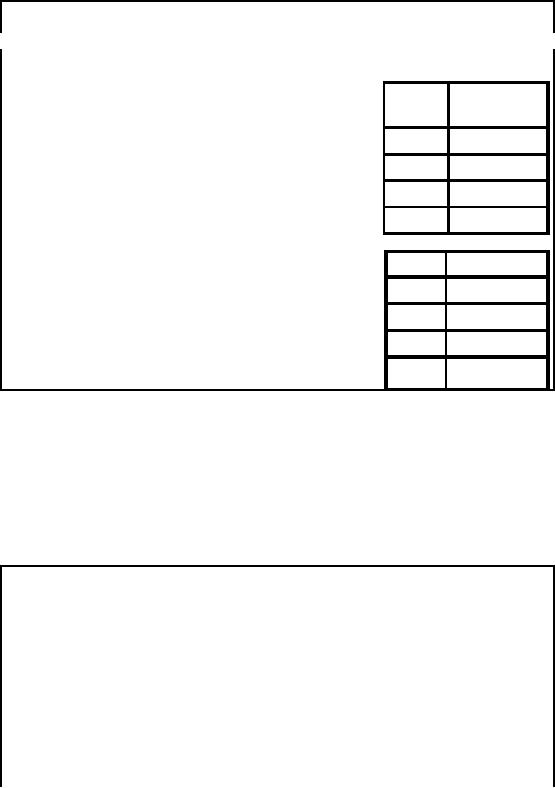 |

Lecture-15
Issues of
Dimensional Modeling
Step 3:
Additive vs. Non-Additive
facts
�
Additive
facts are easy to work
with
Month
Crates
of
� Summing
the fact value gives
Bottles
Sold
meaningful
results
� Additive
facts:
May
14
� Quantity
sold
Jun.
20
� Total
Rs. sales
Jul.
24
�
Non-additive
facts:
� Averages
(average
TOTAL
58
sales
price, unit price)
� Percentages
(%
Month
%
discount
discount)
� Ratios
(gross margin)
May
10
� Count
of distinct
products
sold
Jun.
8
Jul.
6
TOTAL
24%
?
Incorrect!
There
can be two types of facts
i.e. additive and non-additive.
Additive facts are those
facts which
give
the correct result by an
addition operation. Examples of such
facts could be number of items
sold,
sales amount etc.
Non-additive facts can also
be added, but the addition
gives incorrect
results.
Some examples of non-additive
facts are average, discount,
ratios etc. Consider
three
instances of 5,
with the sum being 15 and
average being 5. Now consider two
numbers i.e. 5 and
10, the
sum being 15, but the average being
7.5. Now if the average of 5
and 7.5 is taken
this
comes to be
6.25, but if the average of
the actual numbers is taken,
the sum comes to be 30
and
the average
being 6. Hence averages, if added
gives wrong results. Now
facts could be averages,
such as
average sales per week etc,
thus they are perfectly legitimate
facts.
Step-3:
Classification of Aggregation
Functions
�
How
hard to compute aggregate
from sub-aggregates?
�
Three
classes of aggregates:
�
Distributive
� Compute
aggregate directly from
sub-aggregates
� Examples:
MIN, MAX ,COUNT, SUM
�
Algebraic
� Compute
aggregate from constant-sized
summary of subgroup
� Examples:
STDDEV, AVERAGE
� For
AVERAGE, summary data for
each group is SUM,
COUNT
108

�
Holistic
� Require
unbounded amount of information
about each subgroup
� Examples:
MEDIAN, COUNT
DISTINCT
� Usually impractical
for a data
warehouses!
We see
that calculating aggregates from
aggregates is desirable, but is not
possible for non -
additive
facts. So we deal with three
types of aggregates i.e.
distributive that are
additive in
nature,
and then algebraic which
are non-additive in nature.
Therefore, such aggregates
have to be
computed
from summary of subgroups to
avoid the problem of incorrect
results. The of
course
are
the holistic aggregates that
give a complete picture of the
data, such as median, or
distinct
values.
However, such aggregates are
not desirable for a data
warehouse environment, as it
requires a
complete scanning, which is
highly undesirable as it consumes
lot of time.
Step-3:
Not recording
Facts
�
Transactional fact
tables don't have records
for events that don't
occur
� Example:
No records(rows) for products that were
not sold.
�
This
has both advantage and
disadvantage.
� Advantage:
� Benefit of
sparsity of data
� Significantly
less data to store for
"rare" events
�
Disadvantage:
Lack of information
�
Example:
What products on promotion were not
sold?
Fact
tables usually don't records
events that don't happen,
such as items that were not
sold. The
advantage of this
approach is getting around the problem of
sparsity. Recall that when
we
discussed
MOLAP, we discussed the
sales of different items not occurring in
different
geographies
and in different time frames, resulting
in sparse cubes. If however
this data is not
recorded,
then significantly less data
will be required to be stored.
But what if, from the
point of
view of
decision making, such data
has to be retrieved, how to retrieve
data corresponding to
those
items? To find such items,
additional queries will be required to
check the current item
balance
with the item balance when
the items where (say) brought
into the store. So the
biggest
disadvantage of
this approach is key data is
not recorded.
Step-3: A
Fact-less Fact
Table
�
"Fact
-less" fact table
� A fact
table without numeric fact
columns
�
Captures
relationships between
dimensions
�
Use a
dummy fact column that
always has value 1
The
problem of not recording non-events is
solved by using fact -less fact tables,
as not recording
such
information resulted in loss of
data. Such a fact -less fact
table is one which does
not have
numeric values
stored in the corresponding column, as
such tables are used to
capture the
relationships
between dimensions. Fact
less fact table captures
the many-to-many
relationships
109

between
dimensions, but contains no numeric or
textual facts. To achieve this dummy
value of 1
is used in
the corresponding
column.
Step-3:
Example: Fact-less Fact
Tables
Examples:
�
Department/Student
mapping fact table
�
What is
the major for each
student?
�
Whi ch students
did not enroll in ANY
course
�
Promotion
coverage fact table
�
Which products
were on promotion in which stores
for which days?
�
Kind of
like a periodic snapshot
fact
Some of
the examples of fact -less fact
tables. Consider the case of a
department/student mapping
fact table.
The data is recorded for
each student who registers
for a course, but there may
be
students
that do not register in any
course. If data is useful from
the point of view of
identifying
those
students which are skipping a
semester. There is no direct or simple
way to identify such
students,
the solution is a fact -less fact table.
Similarly which items on
promotion are not selling,
as the
sales records are for
only those items that
are sold.
Step-4:
Handling Multi-valued
Dimensions?
�
One of
the following approaches is
adopted:
�
Drop
the dimension.
�
Use a
primary value as a single
value.
�
Add
multiple values in the dimension
table.
�
Use
"Helper" tables.
For
handling the exceptions in
dimensions, designers adopt
one of the following
approaches:
�
Drop
the Maintenance_Operation dimension as it
is multi-valued.
�
Choose
one value (as the
"primary" maintenance) and
omit the other
values.
�
Extend
the dimension list and add a
fixed number of maintenance
dimensions.
�
Put a
helper table in between this fact
table and the Maintenance
dimension table.
Instead of
ignoring the problem and
dropping the dimension
altogether, let's tackle the
problem.
Usually
the designers go for the
second alternative, as a consequence this
will show up as the
primary, or main
maintenance operation. Such as
20,000 Km maintenance or 40,000
Km
maintenance. It
is known what would constitute
for each mileage based
maintenance, and
these
maintenance
are also mutually exclusive
i.e. single valued. In many
cases , you may actually
come
110

across
this practice being observed in
the OLTP systems. The
obvious advantage is that
the
modeling problem
is resolved, but the disadvantage is that
the usefulness of the data
becomes
questionable.
Why? Because with the
passage of time or with new
models of vehicles coming or
because of
company policy, what constitutes service
at 20,000 Km may actually
change. Will
need
meta data to resolve this
issue.
The
third alternative of creating a fixed
number of additional columns in the
dimension table is a
quick
and dirty approach and
should be avoided. There is likely to be
car that may require
more
changes
then reflected in the table, or
the company policy changes
and more items fall under
the
maintenance,
and a long list will result
i n many null entries for a
typical car, especially new
ones.
Furthermore, it is not
easy to query the multiple
separate maintenance dimensions
and will result
in slow
queries. Therefore, multiple
dimensions style of design
should be avoided.
The
last alternative is usually adopted, and
a "helper" table is placed
between the
Maintenance
dimension and
the fact table, although this
adulterates or dilutes the star
schema. More details
are
beyond
the scope of this
course.
Step-4:
OLTP & Slowly Changing
Dimensions
OLTP
systems not good at tracking the past.
History never
changes.
OLTP
systems are not "static"
always evolving, data
changing by overwriting.
Inability of
OLTP systems to track
history, purged after 90 to 180
days.
Actually
don't want to keep historical data
for OLTP system.
One major
difference between an OLTP system
and a data warehouse is the
ability and the
responsibility to
accurately describe the
past. OLTP systems are
usually very poor at correctly
representing a
business as of a month or a year ago
for several reasons as discussed
before. A
good OLTP
system is always evolving.
Orders are being filled and,
thus, the order backlog
is
constantly
changing. Descriptions of products,
suppliers, and customers are
constantly being
updated, usually
by overwriting. The large volume of
data in an OLTP system is typically
purged
every 90 t o 180
days. For these reasons, it
is difficult for an OLTP
system to correctly represent
the
past. In an OLTP system, do
you really want to keep
old order statuses, product
descriptions,
supplier
descriptions, and customer
descriptions over a multiyear
period?
Step-4:
DWH Dilemma: Slowly Changing
Dimensions
The
responsibility of the DWH to track
the changes.
Example: Slight
change in description, but
the prod uct ID (SKU) is
not changed.
Dilemma:
Want to track both old and
new descriptions, what do they
use for the key?
And where
do they put
the two values of the
changed ingredient attribute?
The
data warehouse must accept
the responsibility of accurately describing
the past. By doing
so,
the
data warehouse simplifies the
responsibilities of the OLTP
system. Not only does
the data
warehouse
relieve the OLTP system of
almost all forms of reporting, but
the data warehouse
contains
special structures that have
several ways of tracking historical
data.
111

A dimensional
data warehouse database
consists of a large central fact table
with a multipart key.
This fact
table is surrounded by a single layer of
smaller dimension tables,
each containing a
single primary
key. In a dimensional database, these
issues of describing the past
mostly involve
slowly
changing dimensions. A typical slowly
changing dimension is a product dimension
in
which
the detailed description of a
given product is occasionally
adjusted. For example, a
minor
ingredient
change or a minor packaging
change may be so small that
production does not
assign
the product a
new SKU number (which the
data warehouse has been
using as the primary key
in
the product
dimension), but nevertheless gives the
data wa rehouse team a revised
description of t
he product. The
data warehouse team faces a
dilemma when this happens. If
they want the
data
warehouse to
track both the old and
new descriptions of the product,
what do they use for
the
key?
And where do they put the
two values of the changed
ingredient
Step-4:
Explanation of Slowly Changing
Dimensions...
�
Compared to fact
tables, contents of dimension tables
are relatively
stable.
� New
sales transactions occur
constantly.
� New
products are introduced
rarely.
� New
stores are opened very
rarely.
�
The
assumption does not hold in
some cases
� Certain
dimensions evolve with
time
� e.g.
description and formulation of products
change with time
� Customers
get married and divorced,
have children, change addresses
etc.
� Land
changes ownership
etc.
� Changing
names of sales
regions.
For
example, a minor ingredient change or a
minor packaging change may
be so small that
production does
not assign the product a new
SKU number (which the
data warehouse has
been
using as the
primary key in t he product dimension), but
nevertheless gives the data
warehouse
team a revised
description of t he product. The
data warehouse team faces a
dilemma when this
happens. If
they want the data warehouse
to track both the old and
new descriptions of
the
product, what do
they use for the
key? And where do they put
the two values of the
changed
ingredient
attribute?
Other common
slowly changing dimensions are
the district and region
names for a sales
force.
Every
company that has a sales
force reassigns these names
every year or two. This is
such a
common problem
that this example is
something of a joke in data ware housing
classes. When the
teacher
asks, "How many of your
companies have changed the organization
of your sales force
recently?"
everyone raises their hands.
Step-4:
Explanation of Slowly Changing
Dimensions...
Although
these dimensions change but
the change is not
rapid.
Therefore
called "Slowly" Changing
Dimensions
There
can be many examples. For a
young customer who is single,
then after a w ile
the
h
customer
gets married. After sometime
there are children, in unfortunate cases
the marriage
breaks so
the customer is separated or
the husband dies and
the customer becomes a
widow. This
just
does not typically happen
overnight but takes a while. Another
example is inheritance,
consider
the example of land. Over a
period of time the land changes
hands, is split because of
112

inheritance or
its size increases by buying.
Again things don't happen
overnight, but take a
while,
hence
slowly changing dimens
ions.
Step-4:
Handling Slowly Changing
Dimensions
�
Option-1:
Overwrite History
� Example:
Code for a city, product
entered incorrectly
�
Just
overwrite the record
changing the values of
modified attributes.
�
No keys
are affected.
�
No changes
needed elsewhere in the
DM.
�
Cannot
track history and hence not a good
option in DSS.
The
first technique is the
simplest and fastest. But it
doesn't maintain past history!
Nevertheless,
overwriting is
frequently used when the data
warehouse team legitimately decides
that the old
value of
the changed dimension attribute is not
interesting . For example, if you
find incorrect
values in the
city and state attributes in a
customer record, then
overwriting would
almost
certainly be
used. After the overwrite,
certain old reports that
depended on the city or
state values
would not return
exactly the same values.
Most of us would argue that
this is the correct
outcome.
Step-4:
Handling Slowly Changing
Dimensions
�
Option-2:
Preserve History
�
Example:
The packaging of a part change
from glued box to stapled box, but
the
code
assigned (SKU) is not
changed.
�
Create an
additional dimension record at the time of
change with new
attribute
values.
�
Segments history
accurately between old and
new description
�
Requires adding
two to three version numbers
to the end of key.
SKU#+1,
SKU#+2
etc.
Suppose you
work in a manufacturing company and
one of your main data
warehouse schemas is
the
company's shipments. The product
dimension is one of the most important
dimensions in this
dimensional
schema. A typical product dimension would
have several hundred detailed
records,
each
representing a unique product capable of being
shipped. A good product dimension
table
would
have at least 50 attributes describing
the products, including hierarchica l
attributes such as
brand and
category, as well as nonhierarchical
attributes such as color and
package type. An
important attribute
provided by manufacturing operations is
the SKU number assigned to
the
product.
You should start by using
the SKU number as the key to
the product dimension table.
Suppose
that manufacturing operations makes a
slight change in packaging of SKU
#38, and the
packaging
description changes from "glued
box" to "pasted box." Along
with this change,
manufacturing
operations decides not to change
the SKU number of the product, or
the bar code
(UPC)
that is printed on the box.
If the data warehouse team
decides to track this
change, the best
way to do
this is to issue another product
record, as if the pasted box
version were a brand new
113

product. The
only difference between the
two product records is the
packaging description. Even
the
SKU numbers are the
same. The only way you
can issue another record is
if you generalize
the
key to the product dimension table to be
something more than the SKU
number. A simple
technique is to
use the SKU number plus
two or three version digits. Thus
the first instance of
the
product key
for a given SKU might be
SKU# + 01. When, and
if, another version is
needed, it
becomes
SKU# + 02, and so on.
Notice that you should
probably also park t he SKU number in
a
separate
dimension attribute (field) because you
never want an application to be parsing
the key
to extract
the underlying SKU number.
Note the separate SKU attribute in
the Product dimension
in Figure
1.
This
technique for tracking slowly
changing dimensions is very
powerful because new
dimension
records
automatically partition history in the
fact table. The old version
of the dimension record
points to
all history in the fact table
prior to the chang e. The
new version of the dimension
record
points to all
history after the change.
There is no need for a
timestamp in the product table
to
record the
change. In fact, a timestamp in the
dimension record may be meaningless
because the
event of
interest is t he actual use of
the new product type in a
shipment. This is best
recorded by
a fact table
record with the correct new
product key.
Another
advantage of this technique is
that you can gracefully
track as many changes to
a
dimensional item as you wish.
Each change generates a new
dimension record, and each
record
partitions history perfectly.
The main drawbacks of the
technique are the requirement
to
generalize
the dimension key, and the
growth of the dimension table
itself.
Step-4:
Handling Slowly Changing
Dimensions
�
Option-3:
Create current valued
field
�
Example:
The name and organization of
the sales regions change
over time, and
want to know
how sales would have looked
with old regions.
�
Add a
new field called current_region
rename old to previous_region.
�
Sales
record keys are not
changed.
�
Only
TWO most recent changes
can be tracked.
Creating a
Current Value
Field
You
use the third technique when
you want to track a change in a dimension
value, but it is
legitimate to
use the old value
both before and after
the change. This situation
occurs most often
in the infamous
sales force realignments, where although
you have changed the names
of your
sales
regions, you still have a
need to state today's sales
in terms of yesterday's region
names, just
to "see
how they would have done"
using the old organization.
You can attack this
requirement,
not by
creating a new dimension
record as in the second
technique, but by creating a
new "current
value"
field. Suppose in a sales
team dimension table, where the
records represent sales
teams,
you have a
field called "region." When you
decide to rearrange the
sales force and assign
each
team to
newly named regions, you
create a new field in the
sales dimension table
called
"current_region."
You should probably rena me
the old field "previous_region." No
alterations are
made to
the sales dimension record keys or to
the number of sales team
records. These two
fields
now
allow an application to group all
sales fact records by either the
old sales assignments
(previous
region) or the new sales
assignments (current region). This
schema allows only
the
most
recent sales force change to
be tracked, but it offers the
immense flexibility of being able
to
114

state
all of the history by either of the
two sales force assignment
sche mas. It is
conceivable,
although
somewhat awkward, to generalize this
approach to the two most
recent changes. If
many
of these
sales force realignments take
place and it is desired to
track them all, then
the second
technique
should probably be used.
S tep-4:
Pros and Cons of
Handling
�
Option-1:
Overwrite existing
value
+ Simple
to implement
+ No tracking of
history
�
Option-2:
Add a new dimension
row
+ Accurate
historical reporting
+
Pre-computed aggregates
unaffected
+ Dimension
table grows over time
�
Option-3:
Add a new field
+ Accurate
historical reporting to last TWO
changes
+ Record
keys are unaffected
+ Dimension
table size increases
There are
number of ways of handling slowly
changing dimensions. Some of
the methods are
simple,
but not desirable; but
all have their own pros and
cons. The simplest possible
"solution" is
to overwrite
history. If the customer was
earlier single, and gets married,
just change his/here
status
from single to married. Very
simple to implement, but not desirable, as a
DWH is about
recording
historical data, and by virtue of
overwriting, the historical data is
destroyed. Another
option is to
add a row when the dimension
changes, the obvious benefit
is that history is not lost,
but over
the period of time the dimension
table will grow as new rows
are added corresponding
to
the
changes in the dimensions.
The third, rather desirable
approach is to add an additional
column, that
does increase the table
size, but the increase is not non
-deterministic. The column
records
the last two changes, if
the dimension changes more
than twice, then historical data
is
lost.
Step-4:
Junk Dimension
�
Sometimes
certain attributes don't fit
nicely into any
dimension
� Payment
method (Cash vs. Credit Card
vs. Check)
� Bagging
type (Paper vs. Plastic vs.
None)
�
Create
one or more "mix"
dimensions
� Group
together leftover attributes as a
dimension even if not
related
� Reduces
number of dimension tables,
width of fact table
� Works
best if leftover attributes
are
� Few in
number
� Low in
cardinality
� Correlated
�
Other
options
� Each
leftover attribute becomes a
dimension
� Eliminate
leftover attributes that are
not useful
115
A junk
dimension is a collection of random transactional
codes, flags and/or text attributes
that
are
unrelated to any particular dimension.
The junk dimension is simply a
structure that
provides
a convenient
place to store the junk
attributes. A good example would be a
trade fact in a
company
that brokers equity
trades.
The
need for junk dimensions
arises when we are considering single
level hierarchies. The
only
problem
with the single level
hierarchies is that you may
have a lot of them in any
given
dimensional model.
Ideally, the concatenated
primary key of a fact table
should consist of
fewer
than 10
foreign keys. Sometimes, if
all of the yes/no flags are
r presented as single
level
e
hierarchy
dimensions, you may end up
with 30 or more. Obviously, this is an
overly complex
design.
A technique
that allows reduction of the number of
foreign keys in a fact table is
the creation of
"junk"
dimensions. These are just
"made up" dimensions where
you can put several of these
single
level hierarchies. This cuts
down the number of foreign
keys in the fact table
dramatically.
As to the number
of flags before creating a junk
dimension, if there are more
than 15 dimensions,
where five or
more are single level
hierarchies, I start seriously
thinking about combining
them
into
one or more junk dimensions.
One should not indiscriminately
combine 20 or 30 or 80 single
level
hierarchies.
116
Table of Contents:
- Need of Data Warehousing
- Why a DWH, Warehousing
- The Basic Concept of Data Warehousing
- Classical SDLC and DWH SDLC, CLDS, Online Transaction Processing
- Types of Data Warehouses: Financial, Telecommunication, Insurance, Human Resource
- Normalization: Anomalies, 1NF, 2NF, INSERT, UPDATE, DELETE
- De-Normalization: Balance between Normalization and De-Normalization
- DeNormalization Techniques: Splitting Tables, Horizontal splitting, Vertical Splitting, Pre-Joining Tables, Adding Redundant Columns, Derived Attributes
- Issues of De-Normalization: Storage, Performance, Maintenance, Ease-of-use
- Online Analytical Processing OLAP: DWH and OLAP, OLTP
- OLAP Implementations: MOLAP, ROLAP, HOLAP, DOLAP
- ROLAP: Relational Database, ROLAP cube, Issues
- Dimensional Modeling DM: ER modeling, The Paradox, ER vs. DM,
- Process of Dimensional Modeling: Four Step: Choose Business Process, Grain, Facts, Dimensions
- Issues of Dimensional Modeling: Additive vs Non-Additive facts, Classification of Aggregation Functions
- Extract Transform Load ETL: ETL Cycle, Processing, Data Extraction, Data Transformation
- Issues of ETL: Diversity in source systems and platforms
- Issues of ETL: legacy data, Web scrapping, data quality, ETL vs ELT
- ETL Detail: Data Cleansing: data scrubbing, Dirty Data, Lexical Errors, Irregularities, Integrity Constraint Violation, Duplication
- Data Duplication Elimination and BSN Method: Record linkage, Merge, purge, Entity reconciliation, List washing and data cleansing
- Introduction to Data Quality Management: Intrinsic, Realistic, Orr’s Laws of Data Quality, TQM
- DQM: Quantifying Data Quality: Free-of-error, Completeness, Consistency, Ratios
- Total DQM: TDQM in a DWH, Data Quality Management Process
- Need for Speed: Parallelism: Scalability, Terminology, Parallelization OLTP Vs DSS
- Need for Speed: Hardware Techniques: Data Parallelism Concept
- Conventional Indexing Techniques: Concept, Goals, Dense Index, Sparse Index
- Special Indexing Techniques: Inverted, Bit map, Cluster, Join indexes
- Join Techniques: Nested loop, Sort Merge, Hash based join
- Data mining (DM): Knowledge Discovery in Databases KDD
- Data Mining: CLASSIFICATION, ESTIMATION, PREDICTION, CLUSTERING,
- Data Structures, types of Data Mining, Min-Max Distance, One-way, K-Means Clustering
- DWH Lifecycle: Data-Driven, Goal-Driven, User-Driven Methodologies
- DWH Implementation: Goal Driven Approach
- DWH Implementation: Goal Driven Approach
- DWH Life Cycle: Pitfalls, Mistakes, Tips
- Course Project
- Contents of Project Reports
- Case Study: Agri-Data Warehouse
- Web Warehousing: Drawbacks of traditional web sear ches, web search, Web traffic record: Log files
- Web Warehousing: Issues, Time-contiguous Log Entries, Transient Cookies, SSL, session ID Ping-pong, Persistent Cookies
- Data Transfer Service (DTS)
- Lab Data Set: Multi -Campus University
- Extracting Data Using Wizard
- Data Profiling